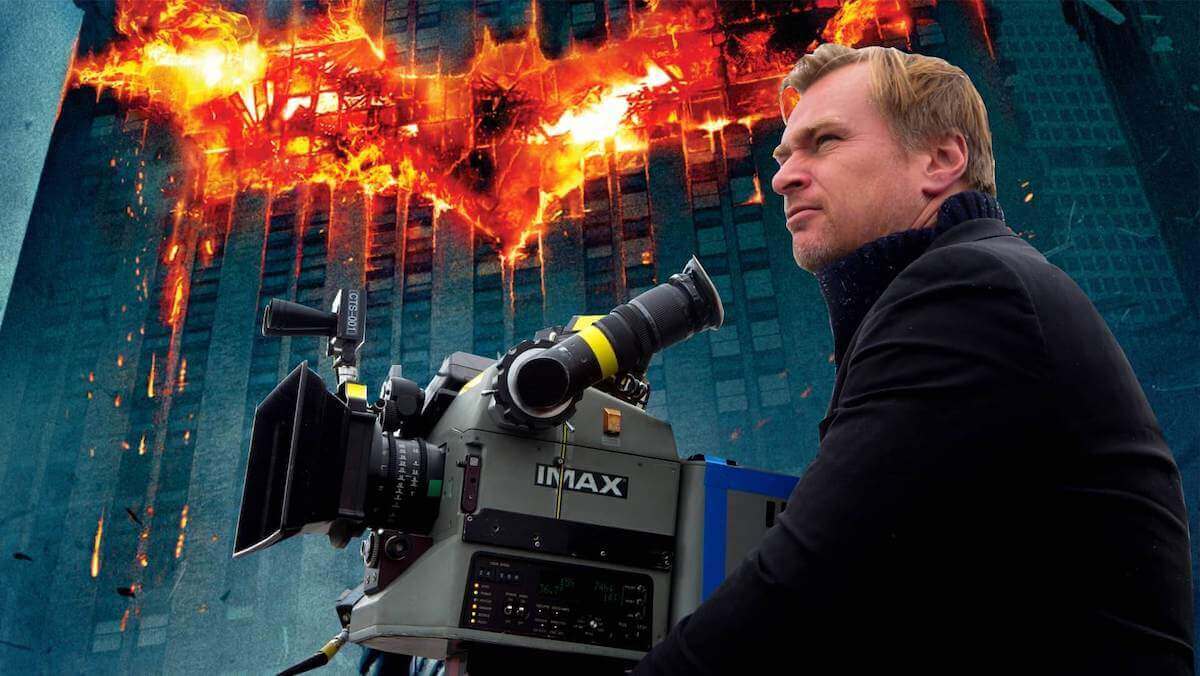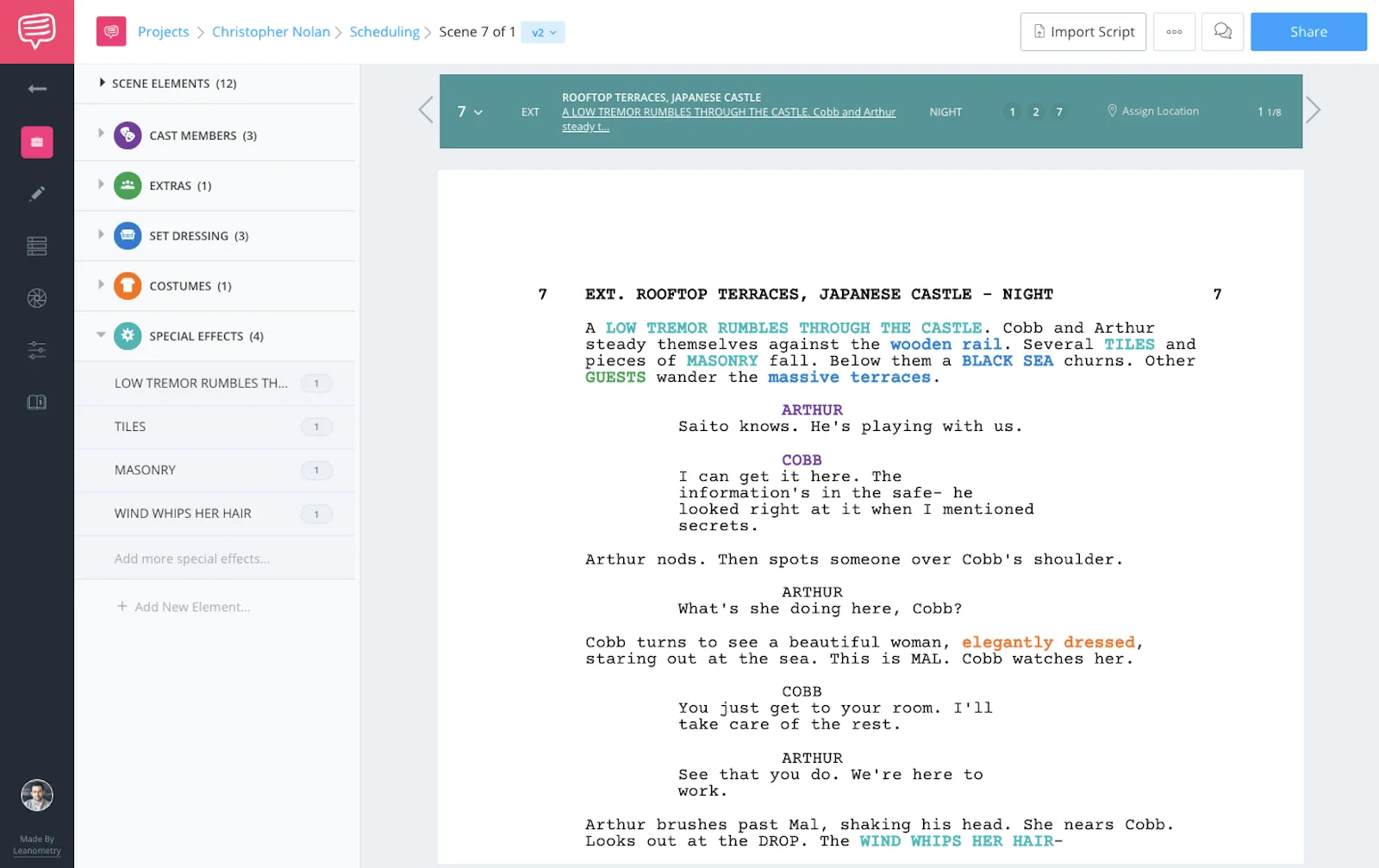Christopher Nolan films include Memento, The Dark Knight Trilogy, The Prestige, and Interstellar. His films Inception and Dunkirk received Academy Award nominations for best picture.
We watched all of Christopher Nolan’s movies, interviews, and documentaries to compile a list of filmmaking tips & techniques.
How to Christopher Nolan Writes & Directs
CHRISTOPHER NOLAN BASICS
The Essential Christopher Nolan
Have you ever heard someone say “history repeats itself”?
This comes up a lot when researching the Christopher Nolan movies.
They are such heavy films — you almost have to take a day to let them sink in before you can move on to the next movie.
While they are pretty tame when compared to Oscar-nominated prestige films or the dark, lurid stories from some of his contemporaries....
They are still pleasantly exhausting.
But why is that?
ChRistopher Nolan
“You get this sort of snowballing momentum, and I wanted to try applying that very rigidly to the entire film, so that we’re creating an intensity of experience that accelerates and carries the audience forward in a way that, hopefully, they’re not used to.”
When you watch a Christopher Nolan movie from start to finish for the first time, you will often experience two conflicting concepts:
“I know where we are.”
And...
“How did we get here?”
This is the unique quality that Nolan has developed over the years, and it’s all based around a shape… The circle.
You’ll find circles all throughout his films..
Dolly moves, VFX composites, barrel rolls, moving sets, black holes, and in many of his films the characters will draw circular diagrams.
Another way Nolan incorporates motifs in movies is through montage. For example, he loves to bookend his films, often with montage sequences that set the stage and wrap everything up. Here's a video breakdown of how Nolan uses montage for various purposes.
How Christopher Nolan Uses Montage • Subscribe on YouTube
Before we dive deeper into his techniques, make sure to brush up on the various Christopher Nolan movies below.
In fact, here's our top list of the best Christopher Nolan movies.
Best Christopher Nolan Movies? We probably didn't change your mind...or did we?
But what makes Christopher Nolan's movies so unique is that he reinforces his method of storytelling with the two main parts of cinema...
Sight and sound.
Auteur Theory Made Practical
Explore directing techniques used by the greats
Create works like these iconic auteur directors. Explore practical directing tips you can immediately put into action on your next project.
EXPLORE Auteur Directors
CHRISTOPHER NOLAN DIRECTING TECHNIQUES
Directing tips from Christopher Nolan
Christopher Nolan has a lot to offer when it comes to directing.
He goes about things differently than many other filmmakers, which is one of the reasons his stories resonate with so many moviegoers.
He disguises many clues to look like an important cinematic device…
Motif
There will be moments in a film that seem as though the story is showing purely subtextual imagery, but this is actually not the case.
Truly, what he actually does… is wave the clue in your face. Like a criminal who returns to the scene of a crime to troll the police. The effect is that it both intrigues and confuses the viewer.
He does this by presenting information with a veiled context. Context that he introduces at optimal points throughout the film. Just enough time to obstruct any big revelation, but not so long that you completely miss out on the significance.
Let’s look at an example of how Christopher Nolan does this with a shot list for a really important scene in Insomnia:
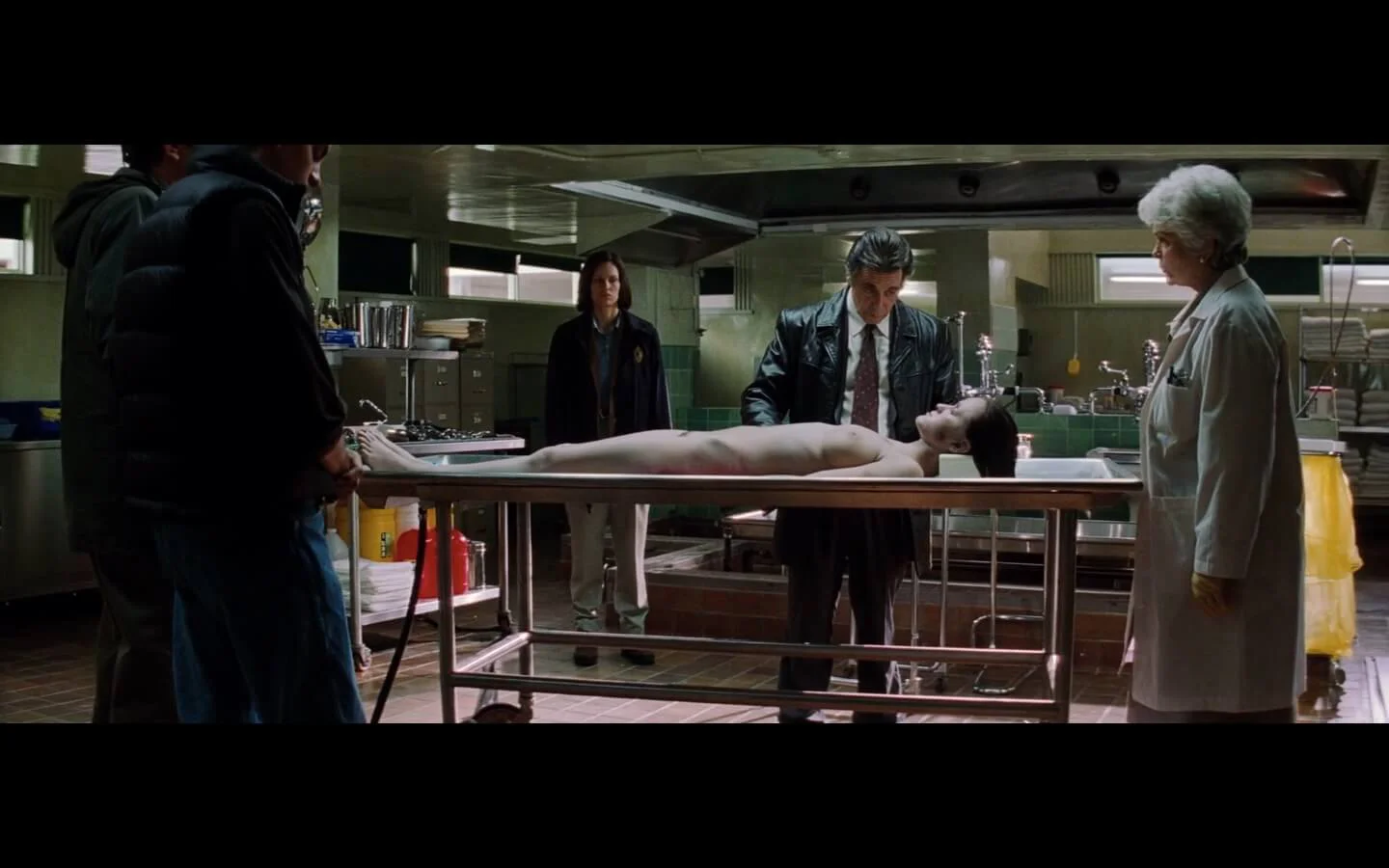
Christopher Nolan Master Shot | Insomnia
This shot above is the master shot for the scene, and while it is relatively simple, you will notice a few things during the scene.
- It establishes orientation for the room.
- It uses a dolly-in for movement toward the action.
- It gives us a somewhat gruesome look at Kay’s body.
- The blocking suggests that Dormer is the center of attention.
Let’s move on to the next shot:
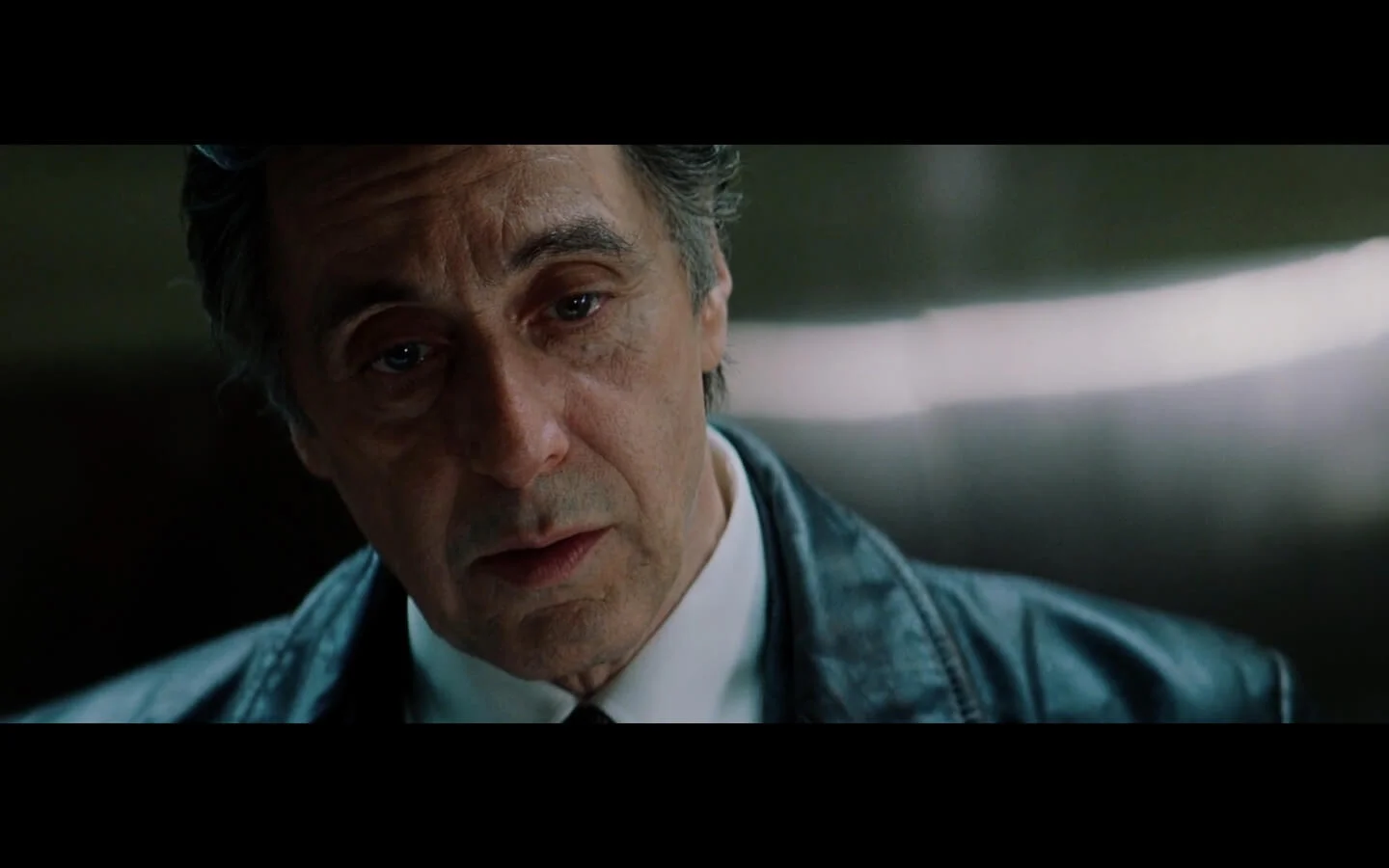
Dormer Coverage | Insomnia
Here is the close-up coverage on Dormer, and this shot is actually the first used in the edit to intro the scene. There are a few takeaways:
- No one else has a true close-up in this scene.
- A slight low angle leads us to the body on the table.
- We get to see all of Dormer’s emotions during the inspection.
Let’s see the next shot:

Dormer Coverage | Insomnia
This shot is complemented by the dialogue. As the pathologist explains some basic information, Dormer points out that the bruises were there before the murder — suggesting that Kay was beaten days prior:
- The shot size tells us that this detail is important.
- Extreme close-up give a gritty feel to gruesome imagery.
- The shallow depth of field allows us to focus on the bruise.
Let’s look at the next shot in this scene:
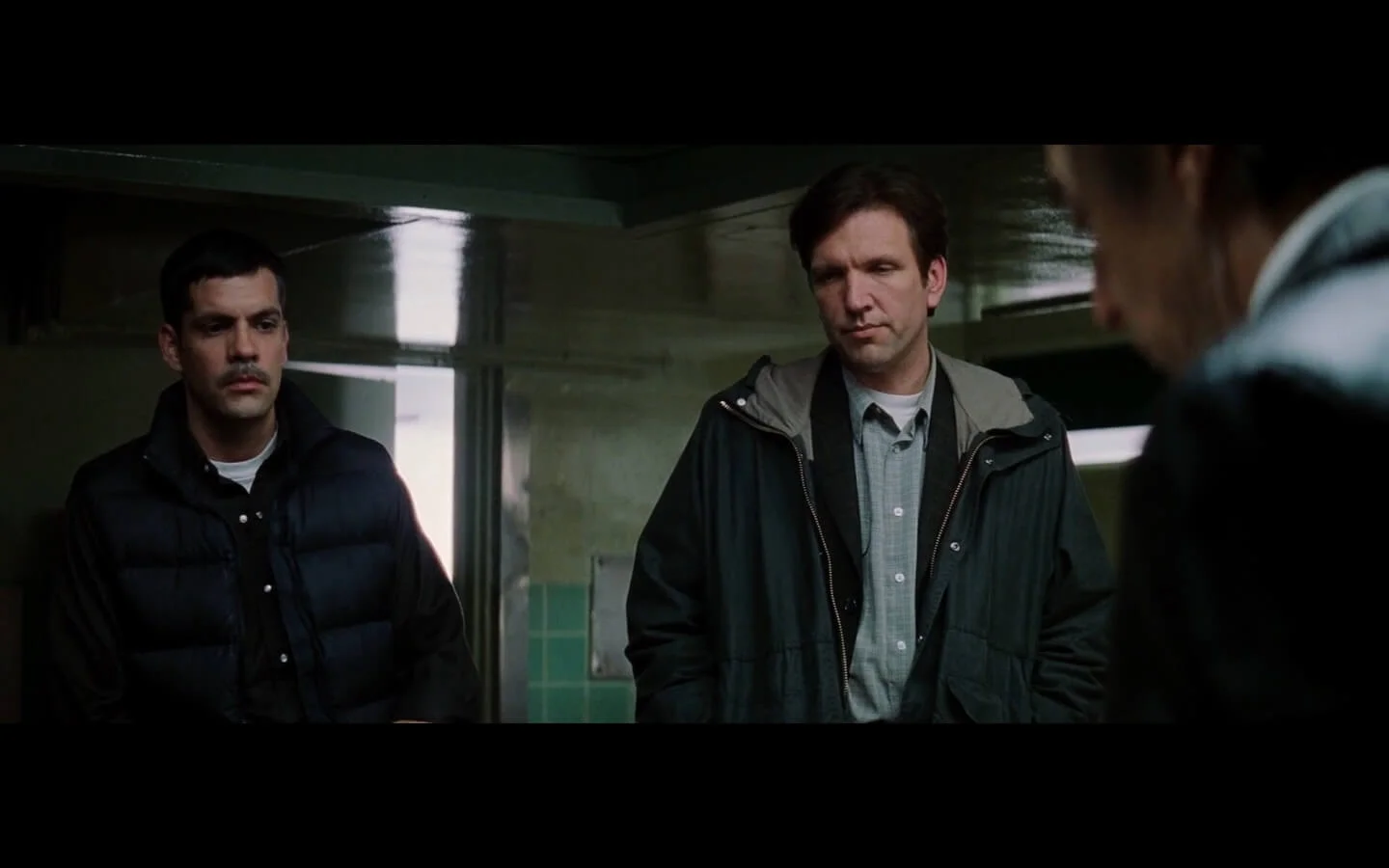
Hap & Duggar Coverage | Insomnia
As the other detectives listen, we get an OTS two-shot on the other detectives. Hap is a bit blase while Duggar looks confused, offended, but also a bit intrigued by the opportunity to watch Dormer at work:
- We gain some extra orientation within the room.
- The blocking tells us that Dormer is a rare detective.
- We feel like another person in the room watching Dormer work.
Let’s check out the next one:
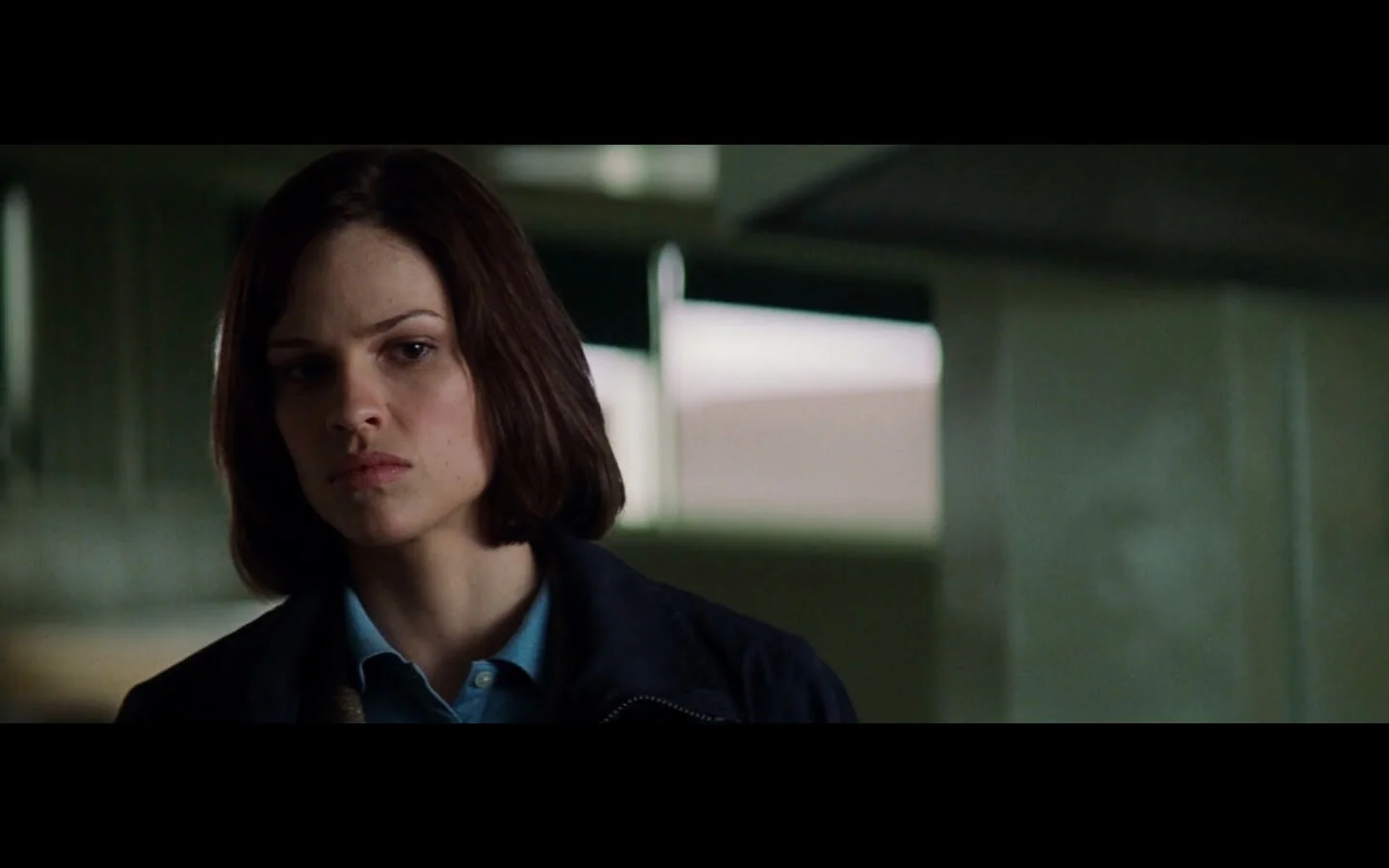
Ellie Coverage | Insomnia
This shot is on Ellie, and she idolizes Dormer:
- Ellie’s performance connects the viewer to the situation.
- Negative space camera right draws our eyes toward the body.
- This medium close-up feels far away like we’re across the room.
Let’s look at the most important shot in the scene:
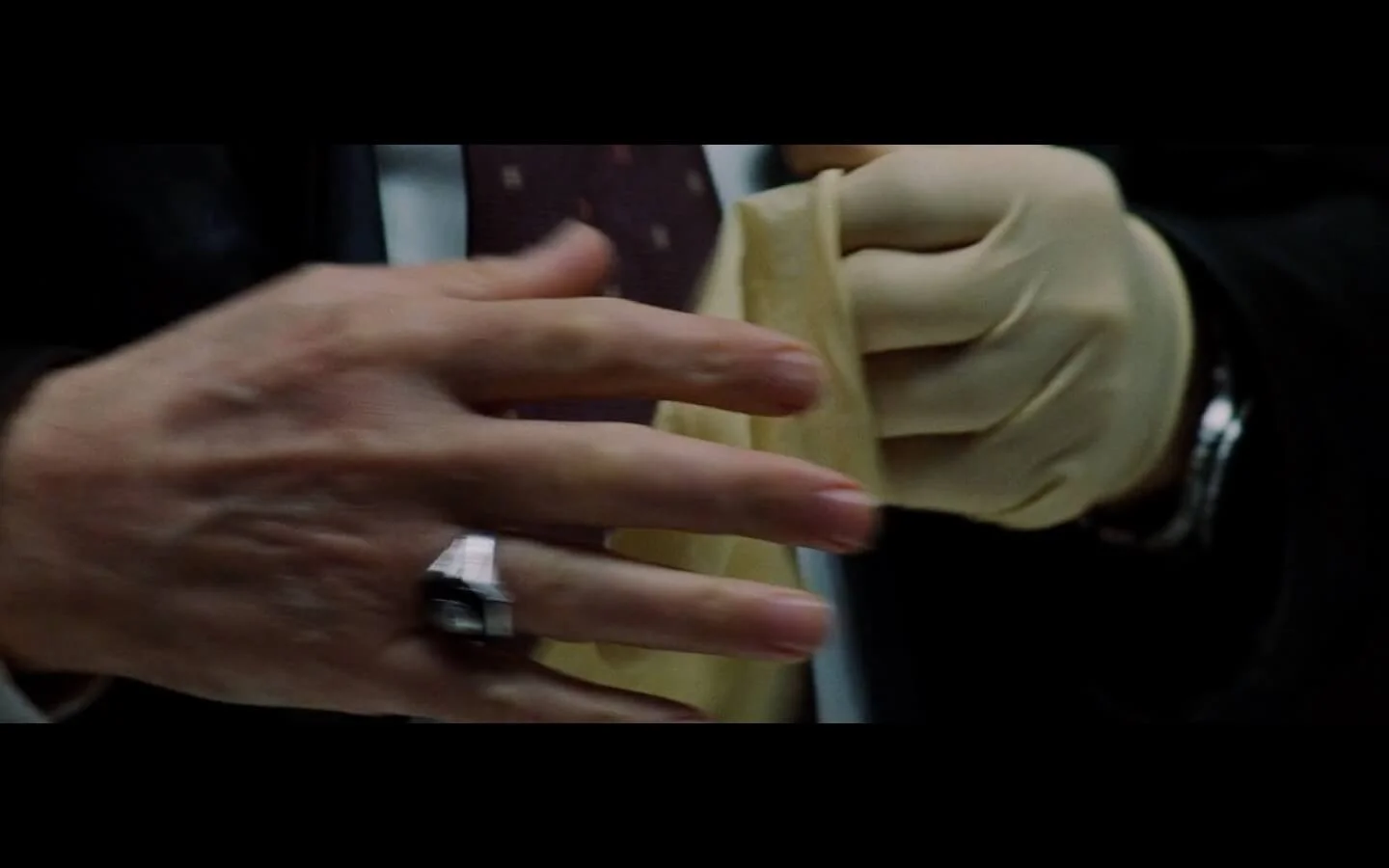
Glove Coverage | Insomnia
There are a few takeaways from this shot:
- Close-up shot size suggests this moment is important.
- The corresponding dialogue has multiple meanings in the story.
- Nolan devoted an entire shot to show Dormer take off his gloves.
Why is this shot so important?
There is a flashback sequence peppered throughout where an obscured figure wearing latex gloves and attempts to clean blood spots off their shirt cuff. Because we're so enveloped in the murder investigation, we naturally assume that the latex gloves belong to Kay's murderer.
The truth is that they are completely unrelated.
The significance of the latex glove shot comes from a previous time that Dormer wore these same types of gloves, and with the proper context, we learn Dormer’s circumstances, and character motivation.
Check out the complete shot list here:
Nolan makes sure that he only makes a film once he has a good script.
While this helps him a lot, what makes Nolan a truly great director is that he takes the concepts on the page and finds a thoughtful way to enhance them through the medium of cinema.
How can you do this with your own stories?
It starts with your script breakdown.
Locate and tag the most important parts of your film — they will be the elements that inform your plot and character motivations:
Then… decide on a way to add cinematic value to those elements.
Either with visuals…
Or with your audio.
You can embed a photo or video for reference directly inside your script breakdown so that your entire team has a clear idea of your needs.
You can also leave a note for your sound department.
Then, make sure to plan shots that show these elements off.
Part of this will be your shot size.
Christopher Nolan will often use extreme-close ups and inserts that provide important pieces of the puzzle.
Opening Credits | Insomnia
For establishing shots, he will use extreme wide shots.
There is more than just your shot size...
Use camera placement, angle, and movement.
In Memento, these decisions change with each of the different sequences.
For the color scenes, the camera is more subjective — he often uses tracking shots that stay over Leonard’s shoulder.
My Wife Deserves Vengeance | Insomnia
Whereas the black and white sections of the film, his decisions were made to create a much more objective experience.
Nolan uses high angles that look down on Leonard, placed up in the corner almost like a security camera.
Hotel Room | Memento
He knows that all of these creative decisions combine to make a whole that is greater than the sum of its parts.
Now, it is important to note that Nolan will very seldom use a POV shot, but instead prefers to do a eye-level tracking shot with his character.
Check out this video to learn about tracking shots:
How to Shoot Better Tracking Shots | StudioBinder
This duel placement allows the audience to see what the character sees without losing the character in the frame.
We get a first-person feel, without sacrificing the benefit of a 3rd person storyteller. And we want that storyteller when navigating the magnificent scope of Nolan’s larger than life worlds.
This subjective “first-and-a-half person” point of view shot pops up in many Nolan films. Like this over-the-shoulder shot from The Prestige.
We see Angier on stage, also with the camera behind him. We see what he sees, but not from his perspective.
Christopher Nolan Movie: The Prestige
Nolan also uses the technique during a foot chase in Insomnia.
The camera tails police detective Will Dormer (Al Pacino) as he pursues murder suspect Walter Finch (Robin Williams).
First, watch the scene:
Christopher Nolan Movie: Insomnia
He urges the audience to experience the chase with, or as, Dormer, while also giving viewers an understanding of the scene that goes beyond Dormer’s perception — a much more complete picture of the action.
Test out this point of view with your own shots by building a shot list. Check out our example of the Insomnia sequence broken down below:
Nolan says he learned camera placement when he was his own camera operator on his first film, The Following.
This shows that it often pays to work other jobs on set before directing.
Auteur Theory Made Practical
Explore directing techniques used by the greats
Create works like these iconic auteur directors. Explore practical directing tips you can immediately put into action on your next project.
EXPLORE Auteur Directors
CHRISTOPHER NOLAN WRITING TIPS
Christopher Nolan script writing tips
Christopher Nolan admits that when he writes a film, he makes sure to write in the same order that it will play on screen…
Especially when it has a non-linear structure.
No writing separate sequences and then cutting and pasting together.
He writes his script with a premeditated momentum.
Let's look at a complete Interstellar script breakdown to see how Nolan uses a circular narrative to bookend his sci-fi epic.
Interstellar Ending Explained • Subscribe on YouTube
Nolan talks about how his new take on structure for Dunkirk was based on the Shepard tone — a sound that seems to continually build to no end.
This same Shepherd tone has been implemented into the score for each and every Christopher Nolan movie since The Prestige.
A tone that, dare I say, revolves around itself, climbing the scale only to come back around to where it began — much like a circle.
A diagram that illustrates the structure of a Nolan movie looks like this:
Christopher Nolan | Memento
This reveals one of the main devices he uses in his storytelling.
Perhaps you’re already familiar with it, but it’s called bookending.
This is where a beginning and end share something identical.
It can be dialogue, props, color schemes, shot sizes, camera movement...
Or an entire scene.
What’s great about bookending is that it forces you to do something that is really important for good filmmaking...
It requires you to survey your entire story to ensure thematic consistency.
One of the last points I want to make is about Christopher Nolan characters.
His best characters are deeply flawed human beings.
Here is a video all about humanizing flawed characters:
How Nightcrawler Creates Empathy for Lou Bloom | StudioBinder
Often there was a defining moment that drives their guilt, and that guilt can either haunt them throughout the film, or motivate them to sink deeper.
Flawed characters don't have to have drinking problems, or beat their wives, or yanks the toe nails off a puppy dog — no!
Nolan knows that a great character will often make compromising decisions for what they believe are the right reasons, and furthermore, that they are obsessed with some value system they hold dear — and can't see the forest for the trees.
People should generally like your characters, but that doesn't mean they have to agree with them all the time, or share a moral compass.
Have some fun with your characters, and lean into their imperfections.
UP NEXT
More on Christopher Nolan
We've got much more to discuss about Christopher Nolan. Follow the navigation below to explore his best films, directing tips, his use of "circles" and some of his shot list favorites.
Auteur Theory Made Practical
Learn the directing techniques used by the greats
Create works like these iconic auteur directors. Explore practical directing tips you can immediately put into action on your next project.
Explore More Auteur Directors
Showcase your vision with elegant shot lists and storyboards.
Create robust and customizable shot lists. Upload images to make storyboards and slideshows.
